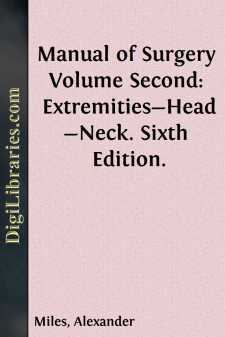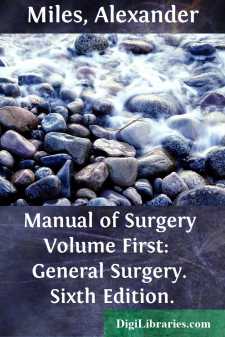Categories
- Antiques & Collectibles 13
- Architecture 36
- Art 48
- Bibles 22
- Biography & Autobiography 813
- Body, Mind & Spirit 142
- Business & Economics 28
- Children's Books 14
- Children's Fiction 11
- Computers 4
- Cooking 94
- Crafts & Hobbies 4
- Drama 346
- Education 46
- Family & Relationships 57
- Fiction 11829
- Games 19
- Gardening 17
- Health & Fitness 34
- History 1377
- House & Home 1
- Humor 147
- Juvenile Fiction 1873
- Juvenile Nonfiction 202
- Language Arts & Disciplines 88
- Law 16
- Literary Collections 686
- Literary Criticism 179
- Mathematics 13
- Medical 41
- Music 40
- Nature 179
- Non-Classifiable 1768
- Performing Arts 7
- Periodicals 1453
- Philosophy 64
- Photography 2
- Poetry 896
- Political Science 203
- Psychology 42
- Reference 154
- Religion 513
- Science 126
- Self-Help 84
- Social Science 81
- Sports & Recreation 34
- Study Aids 3
- Technology & Engineering 59
- Transportation 23
- Travel 463
- True Crime 29
Manual of Surgery Volume Second: Extremities-Head-Neck. Sixth Edition.
by: Alexander Miles
Categories:
Description:
Excerpt
FRACTURES
A fracture may be defined as a sudden solution in the continuity of a bone.
Pathological Fractures
A pathological fracture has as its primary cause some diseased state of the bone, which permits of its giving way on the application of a force which would be insufficient to break a healthy bone. It cannot be too strongly emphasised that when a bone is found to have been broken by a slight degree of violence, the presence of some pathological condition should be suspected, and a careful examination made with the X-rays and by other means, before arriving at a conclusion as to the cause of the fracture. Many cases are on record in which such an accident has first drawn attention to the presence of a new-growth, or other serious lesion in the bone. The following conditions, which are more fully described with diseases of bone, may be mentioned as the causes of pathological fractures.
Atrophy of bone may proceed to such an extent in old people, or in those who for long periods have been bed-ridden, that slight violence suffices to determine a fracture. This most frequently occurs in the neck of the femur in old women, the mere catching of the foot in the bedclothes while the patient is turning in bed being sometimes sufficient to cause the bone to give way. Atrophy from the pressure of an aneurysm or of a simple tumour may erode the whole thickness of a bone, or may thin it out to such an extent that slight force is sufficient to break it. In general paralysis, and in the advanced stages of locomotor ataxia and other chronic diseases of the nervous system, an atrophy of all the bones sometimes takes place, and may proceed so far that multiple fractures are induced by comparatively slight causes. They occur most frequently in the ribs or long bones of the limbs, are not attended with pain, and usually unite satisfactorily, although with an excessive amount of callus. Attendants and nurses, especially in asylums, must be warned against using force in handling such patients, as otherwise they may be unfairly blamed for causing these fractures.
Among diseases which affect the skeleton as a whole and render the bones abnormally fragile, the most important are rickets, osteomalacia, and fibrous osteomyelitis. In these conditions multiple pathological fractures may occur, and they are prone to heal with considerable deformity. In osteomalacia, the bones are profoundly altered, but they are more liable to bend than to break; in rickets the liability is towards greenstick fractures.
Of the diseases affecting individual bones and predisposing them to fracture may be mentioned suppurative osteomyelitis, hydatid cysts, tuberculosis, syphilitic gummata, and various forms of new-growth, particularly sarcoma and secondary cancer. It is not unusual for the sudden breaking of the bone to be the first intimation of the presence of a new-growth. In adolescents, fibrous osteomyelitis affecting a single bone, and in adults, secondary cancer, are the commonest local causes of pathological fracture.
Intra-uterine fractures and fractures occurring during birth are usually associated with some form of violence, but in the majority of cases the fœtus is the subject of constitutional disease which renders the bones unduly fragile....



